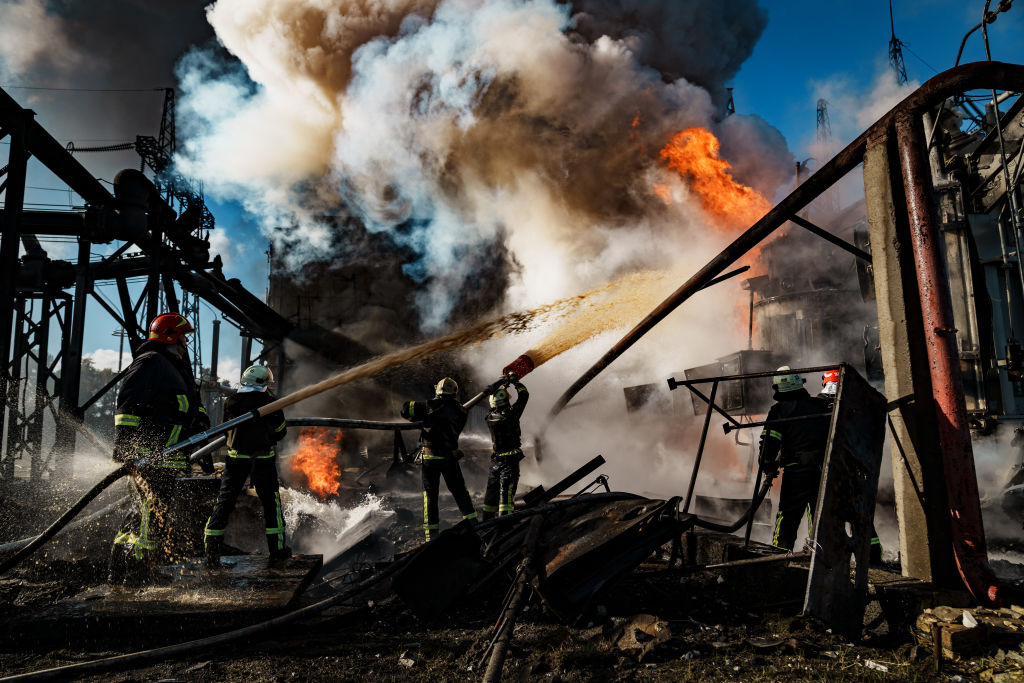
There are many ways to measure the consequences of Russia’s full-scale invasion of Ukraine, which began a year ago on Friday, Feb. 24, 2022. Most of them—7,200 Ukrainian civilians killed, 8 million forced to flee abroad, a global hunger crisis driven by surging food prices—paint an unremittingly tragic picture, for both Ukraine and the world. For the climate though, it’s a little different.
Twelve months in, the war’s decidedly mixed carbon impact is coming into view. Inside Ukraine, experts have tracked vast amounts of the greenhouse gasses that have been unleashed by Vladimir Putin’s path of destruction. Outside of Ukraine, though, the opposite has happened. To many analysts’ surprise, Putin’s decision to squeeze gas exports to Europe last summer has pushed the region’s emissions down in recent months. It has also accelerated a global phase out of fossil fuels: just ask British oil major BP, which in January revised its pre-invasion estimates to predict a much sharper decline in demand for fossil fuels in 2035, citing countries’ post-war belief that renewables provide better energy security.
But let’s look at the bad climate news first. Forest fires sparked by fighting, attacks on the Nord Stream 1 and 2 gas pipelines, the need to rebuild hundreds of thousands of blasted buildings, plus the millions of fossil-fueled journeys by soldiers, munitions, and refugees, adds up to a lot of extra carbon pollution. Russia’s targeting of Ukraine’s energy system, starting in October, has been particularly damaging: as oil depots and gas power plants have exploded, releasing carbon and methane into the air, Ukrainians have been forced to rely on dirtier fuels to keep warm. “We saw a huge influx of inefficient [diesel-powered] generators in November and December,” says Lennard de Klerk, a Dutch carbon accounting expert in Kyiv preparing a report on the war’s greenhouse gas impact, due to be presented to the U.N. in June.
Read more: Ukraine Wants Russia to Pay for the War’s Environmental Impact
De Klerk puts the first year of war’s carbon footprint in the region of 155 million metric tons, roughly the annual emissions of the Netherlands. Some of that will have been offset by the fact that Ukranians likely didn’t emit as much carbon as they normally do in a year (202 million metric tons in 2021): energy demand has fallen due to the shuttering of industries and the fact that 18% of the population was forced to flee to the safety of nearby countries. De Klerk, though, says much of that economic activity and residential energy use will simply have migrated to other European countries.
The better—if not exactly good—news is that Europe slashed its emissions in the later part of 2022. Many climate advocates had feared that Russia’s suspension of natural gas exports to the E.U. would force the bloc to use more coal, which is twice as polluting. And some countries, including Germany and the U.K., did extend the life of coal plants that were due to be shut down. But the far more dominant trend was a fall in energy use. Europeans responded to dizzyingly high gas prices by turning down their gas-powered home heating—an option made more feasible by an unusually mild winter—or closing down businesses that couldn’t pay their energy bills. The E.U.’s non-electricity natural gas consumption has fallen 17% year-over-year since the start of the war—which translates to 117 metric tons of avoided carbon emissions, according to Lauri Myllyvirta, lead analyst at the Finland-based Centre for Research on Energy and Clean Air. “Europe’s CO2 emissions overall would have been higher without the invasion and Putin’s attempts at an energy war.”
To be clear, Ukrainian lives ruined, businesses imploding, and Europeans unable to afford heating are no one’s idea of a good way to cut carbon. But it’s hard to ignore the push towards cleaner, more efficient energy spurred by Putin’s actions over the last year. In 2022, as fossil fuel prices rose and European leaders sought to wean the region off Russian fossil fuels, the amount of solar capacity installed jumped a staggering 47% compared to 2021. Sales of heat pumps, an electric alternative to gas heating, jumped 37%; sales of electric vehicles rose 31%. Some of the more coordinated efforts to cut energy use will be helpful even if energy prices fall: for example, the rollout of apps to help people use electricity at low-demand times, or programs to better insulate homes to improve energy efficiency.
If such changes continue to accelerate, as Myllyvirta predicts they will in 2023, it won’t only bring us closer to our climate goals. It will also bring us closer to a world in which leaders who depend on fossil fuels for their power lose their ability to wage pointless wars.
A version of this story also appears in the Climate is Everything newsletter. To sign up, click here.
More Must-Reads from TIME
- Cybersecurity Experts Are Sounding the Alarm on DOGE
- Meet the 2025 Women of the Year
- The Harsh Truth About Disability Inclusion
- Why Do More Young Adults Have Cancer?
- Colman Domingo Leads With Radical Love
- How to Get Better at Doing Things Alone
- Michelle Zauner Stares Down the Darkness
Write to Ciara Nugent at ciara.nugent@time.com